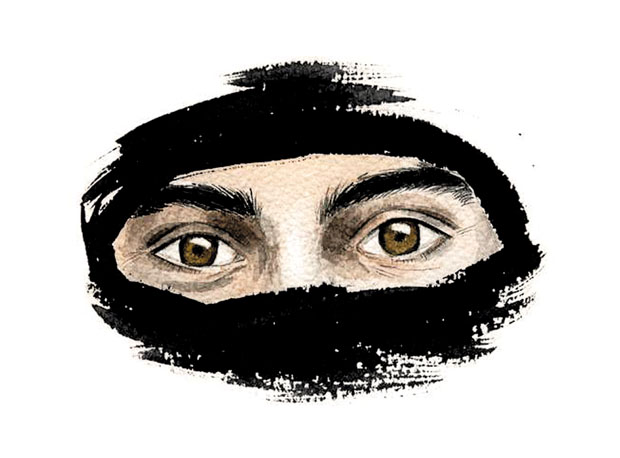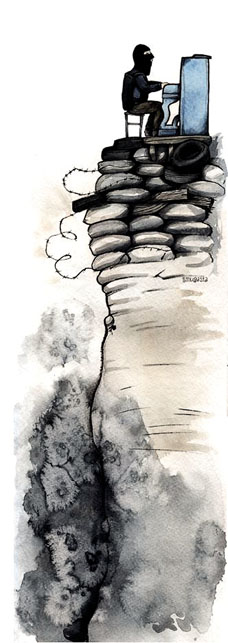“Each helps as he can…”
Artist Marysia RUDSKA on the Euromaidan’s muses, space of freedom, and creative reflections of artists
A commonly known saying goes: “When the cannons roar the muses fall silent.” However, the realities of recent months in Ukraine have proved the opposite: the revolution is increasingly inspiring artists to create new and interesting works. The Day spoke to young artist and children’s books illustrator Marysia Rudska to clarify why symbols and heroes of the Euromaidan had replaced animals, real and mythical, as the main theme of her work.
You created a series of pictures of the Ukrainian revolution. When your personal participation in the protests started, and did your first creative ideas on this topic appeared at the same time?
“As deeply apolitical as I am, at some point I realized I needed to go and help. I helped with my mere presence at first, but when things went definitely downhill, I started to help with food and medicines, thus providing logistics support as a Kyivite and a human being. My artistic participation began on January 19, when the events started in Hrushevsky Street. I noticed that many other artists also took up this theme at the same time. It looked like it was a universal mood, with everyone doing their best – some standing at the frontline barricades and throwing stones at riot police, others managing to write a poem or draw a picture. Generally, the Euromaidan marks the first time that events in this country inspired me to create art. I used to delimit clearly creativity and civic stance.”

How did your work on this series of pictures begin?
“The first picture came to me... in a dream. It is called Flowers for Riot Police. In the dream, I saw it as a vytynanka, but when I woke up, I decided to choose the linocut technique, where an image is cut in linoleum or rubber with a knife, and then coated with paint and stamped on paper. I offered on Facebook to give this stamps, every of them unique, for free to people who would support hromadske.tv with their money. Journalism serves as our eyes and conscience now, we learn from journalists what is really happening. Therefore, I wanted to support them.
 “Later, when I saw that horrible video of Cossack Mykhailo Havryliuk’s mistreatment, I just had to do something with these emotions. I decided to paint him as a winner, with all evil lying at his feet, and thus give some moral boost to him. I should say that Havryliuk has a remarkable face, but his reaction to the events and his fortitude were even more remarkable. No wonder that several artists noticed and pictured it all. Portrait of Bulatov was a continuation of the series devoted to the struggle between heroism and ugliness, reflecting a mythologizing approach to the events. It took me longer to develop Bulatov’s image, because Havryliuk was clearly a Cossack, but Bulatov was a Kyivan Rus’ knight-errant in my imagination. There is some undertone to it, too, as Russians often see the entire legacy of Kyivan Rus’ as their exclusive property, so I wanted also put a fair claim to this legacy.
“Later, when I saw that horrible video of Cossack Mykhailo Havryliuk’s mistreatment, I just had to do something with these emotions. I decided to paint him as a winner, with all evil lying at his feet, and thus give some moral boost to him. I should say that Havryliuk has a remarkable face, but his reaction to the events and his fortitude were even more remarkable. No wonder that several artists noticed and pictured it all. Portrait of Bulatov was a continuation of the series devoted to the struggle between heroism and ugliness, reflecting a mythologizing approach to the events. It took me longer to develop Bulatov’s image, because Havryliuk was clearly a Cossack, but Bulatov was a Kyivan Rus’ knight-errant in my imagination. There is some undertone to it, too, as Russians often see the entire legacy of Kyivan Rus’ as their exclusive property, so I wanted also put a fair claim to this legacy.
“I have been drawing mythical creatures and fictitious animals for a very long time. They arose as a way to get some protection by creating my own world. However, recent weeks were no time for it, even though these two portraits have some animals on them...”
Which technique did you use to create these works?
“My dominant technique is watercolor. I draw in pencil at first, then double the lines with pen, use markers sometimes, and finish a work by painting it over with watercolors. I like watercolor for its flexibility, it can be employed to create very different effects or play with color saturation. I painted portraits of Havryliuk and Bulatov as well as pictures Extremist and Concert over the Abyss using this technique. These ‘musical stories’ were dictated by stark contrasts. On the one side, here is a revolution, with fire, rocks, and protesters in balaclavas who are not mercenaries, but people with ordinary lives who study or work and have hobbies... Some of them are excellent musicians, and one of them sits down and plays a piece by Beethoven... Other side is trying to cover it all in loud Russian pop music. Thus, Concert over the Abyss pictures the whole system, which actually causes terrible sadness, rather than a Euromaidan activist, which is why the picture has that deep abyss in it.
“Euromaidan-themed art, including music, videos, and pictures, helps protesters and gives them moral support. It can boost the morale and give a sense of importance instead of randomness. However, the original creative stimulus for me is an emotional rush that comes from within. My personal need comes first, and then it is very nice to realize that your pictures are interesting to someone else. New pictures of the Euromaidan are still emerging in my mind, so the series will grow. I like promoting aestheticization of what is happening in this country.
“I think that over time, artists should organize joint exhibitions, as so many works have been created already by artists and photographers alike... We also should publish albums or books, as we did after the Orange Revolution. This must be done after our victory. Generally, the Euromaidan is an incredibly creative space. Here one is not a spectator. When you have an idea there, you know that you are the only to implement it. This is a very important sense of responsibility and having something depending on you, as a citizen and an artist.”
Newspaper output №:
№13, (2014)Section
Time Out





